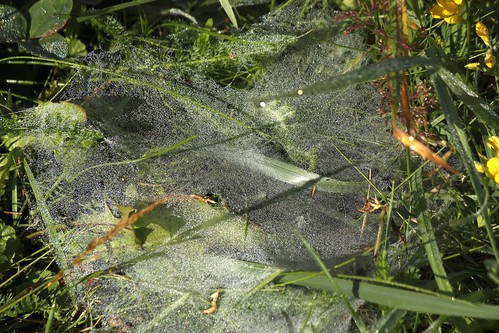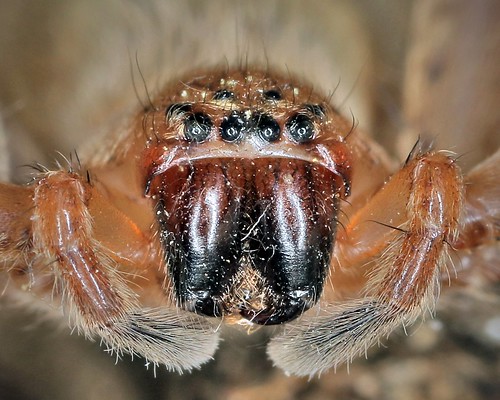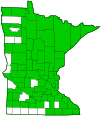funnel weavers
(family Agelenidae)
Overview • Description • Distribution • Taxonomy
Agelenidae spiders are best known for the distinctive webs that they create. The web is a flat sheet with a funnel in which the spider will wait. It may be small or expansive, up to several square feet. It may be sticky to hold prey, or not sticky but with filaments that snare the body or legs of prey. The funnel is usually off to one side, but some species place the funnel in the middle of the web. When a prey is detected, the spider will run out of the funnel, paralyze the captured prey with a venomous bite, and drag it back to the funnel to consume it. Webs can be built in any area with rocks, grass, bushes, or a wall that will support the funnel web. They are commonly seen on lawns in the morning, when they are often covered with dew. They are also built on buildings, including on windowsills and porches, or in buildings, especially in dark corners of basements. |
||
Description |
||
Agelenidae are small to medium-sized spiders, ⅛″ to ¾″ (4 to 20 mm) in length not including the legs. The body is brown with dark and/or light markings. When viewed from above, the front part of the body (cephalothorax) is much narrower in front than behind. When viewed from the side it is relatively flat but is broadly rounded and slopes downward behind the head region. There are eight eyes arranged in two rows of four eyes each. Both rows are strongly curved and close together, so that the anterior median eyes (AME) and the posterior lateral eyes (PLE) form almost a straight line. The eyes are equal or only slightly unequal in size. The jaws (chelicerae) have three teeth. The abdomen is oval and elongated. It usually has two longitudinal rows of lines and spots. There are six silk spinning organs (spinnerets). The rear spinnerets are long and are easily seen extending from the end of the abdomen when viewed from above. The legs are long, brown, and hairy. There are three claws at the end of each leg, but these are not visible to the naked eye. |
||
Distribution |
||||
|
Sources |
|||
| 9/20/2023 | ||||
Taxonomy |
|||
Class |
|||
Order |
|||
Suborder |
Araneomorphae (Typical Spiders) |
||
Infraorder |
Entelegynae |
||
| Zoosection | RTA clade (RTA Clade Spiders) | ||
Zoosubsection |
Marronoid (Meshweavers and Allies) |
||
Subordinate Taxa |
|||
Subfamily Ageleninae (Typical Funnel Weavers) Subfamily Coelotinae |
|||
Synonyms |
|||
|
|||
Common Names |
|||
funnel weavers funnel web spiders |
|||
Glossary
Chelicerae
The pair of stout mouthparts, corresponding to jaws, in arachnids and other arthropods in the subphylum Chelicerata.
Visitor Photos |
|||||
Share your photo of this arachnid. |
|||||
| This button not working for you? Simply email us at info@MinnesotaSeasons.com. Attach one or more photos and, if you like, a caption. |
|||||
Crystal Mattern |
|||||
funnel spider. (I think) I live in Moorhead MN. These are on the sides of my apartment. Are they dangerous? |
 |
||||
MinnesotaSeasons.com Photos |
|||||
|
|||||

Slideshows |
||
| Family Agelenidae Andree Reno Sanborn |
||
 |
||
About
9 genera, 85 species in North America |
||
| Arachnides - Agelenidae Philippe Garcelon |
||
 |
||
About
Les Agelenidae sont de grandes araignées tissant des toiles en Google Translate: The Agelenidae are large spiders that weave webs |
||

Visitor Videos |
|||
Share your video of this arachnid. |
|||
| This button not working for you? Simply email us at info@MinnesotaSeasons.com. Attach a video, a YouTube link, or a cloud storage link. |
|||
Other Videos |
|||
| Funnel-web Spider (Agelenidae) Making Funnel and Defecating Carl Barrentine |
|||
About
Aug 17, 2010 f you look closely, you'll actually see this specimen defecate a urine and feces mixture of guanine as a small white droplet. (There...you can check that off your 'Bucket List'. ;-) Photographed at the Turtle River State Park, North Dakota (16 August 2010). |
|||
| Grass Spider (Agelenidae: Agelenidae: Agelenopsis) Male on Wall Carl Barrentine |
|||
About
Sep 1, 2010 Photographed near Fisher, Minnesota (01 September 2010). |
|||
| Huge Funnel Web... Agelenidae ARACHEUPHORIA |
|||
About
Sep 7, 2022 |
|||

Visitor Sightings |
|||||
Report a sighting of this arachnid. |
|||||
| This button not working for you? Simply email us at info@MinnesotaSeasons.com. Be sure to include a location. |
|||||
| Crystal Mattern 9/13/2023 |
Location: Moorhead MN I live in Moorhead MN. These are on the sides of my apartment. Are they dangerous? |
 |
|||
| John Valo 9/14/2023 |
With just one exception, funnel weavers are not dangerous to humans. The exception is the hobo spider, but in North America that species occurs only in the Pacific Northwest. Here is what BugGuide.net has to say about funnel weavers: These spiders are docile and non-aggressive. They will not bite unless they feel threatened without an option to escape. Most bites occur when gardening, working in wood piles, etc., where the unseen spider is surprised. Attention should be used if a spider is suspected to be in the area you are working; if the spider has a chance to escape... it will! Most bites from most species are not serious, and, at worst, are comparable to a bee sting. Eratigena agrestis ("Hobo Spider" …) is thought to be harmful (necrotic venom), but this is highly uncertain. Just exercise caution if you live in the Pacific Northwest when dealing with a suspected Eratigena. |
||||
MinnesotaSeasons.com Sightings |
|||||
|
|||||

Created: 9/20/2023
Last Updated:
